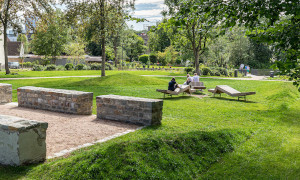The School Construction Conference of the Saxony Chamber of Architects took place in Dresden on 9 and 10 December 2016 - an all-round successful, very stimulating and multi-layered event. The conference was conceived and designed by the Public Relations Committee of the Saxony Chamber of Architects under the direction of Ruairi O'Brien.
On the second day, outdoor space was also a topic - Sigrid Böttcher-Steeb (bdla working group on educational spaces), together with Florian Ehrler from Dresden, shed light on the topic of open spaces at schools. They not only showed the complex range of open space design at schools - from the development to the chill corner, but also asked critical questions about the significance of open space design in the overall complex of school construction and the fair early involvement of landscape architects in the planning process.
On the two days, the House of Architects was fully booked and filled with sometimes hive-like buzzing during the coffee breaks full of discussion - the participants were very well mixed with representatives from many Saxon municipalities and building administrations, architectural and planning offices, ministries, SIB and national speakers (though hardly any landscape architects...).
There is enormous pressure to act on school construction, with a simultaneous multitude of unanswered questions, for example:
- How can quality and a minimum of user participation in the planning process still be made possible with such (protracted) construction pressure as in the growth areas of Leipzig and Dresden, and at the same time enormous cost pressure?
- With which building structures and school grounds can innovative forms of teaching, new learning and inclusive schools be made possible, if there are no clear (innovative) announcements on this either politically or in funding guidelines and building regulations?
- Why are open space planners often involved in the school building process far too late (and sometimes not at all)? Why is outdoor space often criminally neglected? (Some architects have again referred to examples where building services engineers rather than landscape architects have been named as co-authors, or where outdoor space has been postponed to a later day X. )
Sigrid Böttcher-Steeb and Florian Ehrler took clear positions on this. The points of view are formulated in the handout accompanying their presentation. Impressions are also reflected in the flipchart images from the "Green Break Table".
- Latitude: 0
- Longitude: 0


